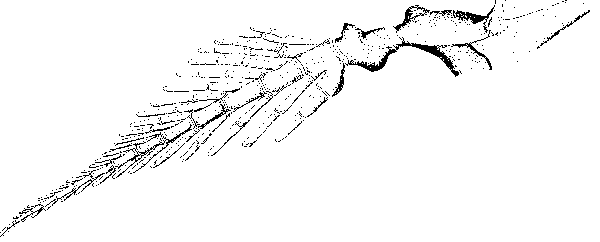
The transition from aquatic to terrestrial life is a major concern in evolutionary theory; therefore the transformation of the appendicular skeleton from fin to terrestrial limb is of special interest. Unlike the situation with the evolution of jaws, where the transition is mysterious and seemingly sudden, there is fossil evidence showing a range of intermediate and supposedly transitional forms among appendicular structures.
How organisms acquired fins in the first place is an unsolved question in the literature, but by extrapolation from the assumption that fins evolved through the serial accretion of slight elaborations, it is often held that the appendicular skeleton gradually became larger, stronger,and more elaborate in number of bones as the tetrapod limb evolved. In other words, there was an elaborative process of some kind which formed the fin, and whatever it was, it just continued, forming the tetrapod limb.
The proposed theory offers a different picture of the evolution of fins and limbs, a model in which limbs or proto-limbs arise suddenly in a primitive many-segmented protovertebrate through parabiotic mutation. Appendicular skeletons are homologous with a longitudinal half of the axial skeleton. Appendicular radials (fin rays, digits) are homologous with the ribs or radials of the axial skeleton.
This model explains the evolution of the anchoring pelvic and pectoral girdles; these are simply reductions and distortions of the proximal radials of the primitive limb. Being originally distinct organisms, the trunk and limbs are fundamentally separate. This explains why the limb bases, the girdles, are so distinct from the axial skeleton. If they had gradually evolved from the axial skeleton they should show more association with neighboring axial skeletal structures, or the axial ribs should show gaps from which parts had migrated to form appendicular structures.
The rays of appendicular fins form from the outer parts of the radials projecting along the limbs, as the rays of the fin seam evolve from the ends of axial ribs. Digital bones are formed from the radials of the limb, from the inner segments of the distal radials. In order for the tetrapod limb to evolve from a fin, sufficient internal bones must be present to form the tetrapod skeleton through reduction alone. This precludes the evolution of tetrapods from anything like a typical modern fish, in which the appendicular skeleton has already been reduced to a few small bones supporting a rayed fin. This also eliminates from consideration as tetrapod progenitors the known coelacanths, which have long been considered to be "on the way" toward the tetrapod state; their appendicular bones are too few in number.
The proposed model implies that a lungfish-like form is in the tetrapod lineage; a coelacanth-like form might have an intermediary role, but it would be one with more limb-bones than any known coelacanth. The known coelacanths represent lineages which became committed to their niches and lost the bones which could have evolved into a more complex limb. This adjustment in thinking is a small price to pay for a comprehensible model which fits the observable pattern of reduction in number of segments.
A theory which must be discussed is the fin-fold theory of the origin of paired limbs. Some ancient fishes had a paired ventral fin seam, the reduction and distortion of which might form bilaterally paired fins. Under the proposed model, this double fin seam evolves from the ends of the rib pairs. The few paired fins which seem to have evolved in this way are relatively simple; they do indeed seem to have migrated from the axial skeleton, leaving gaps in the series of ribs. This theory is appealing in that it does not require the theoretically difficult process of adding new articulated parts. But it does not address the question of the origin of the skeletal elements which are distorted. And more importantly, in the lungfish-coelacanth-rhipidistian lineages the axial ribs show no gaps, and the limbs are complex and show a fading internal bilateral symmetry which should not be present if their parts had migrated from the axial skeleton.
Fig.4 Limb of a lungfish. 
The claws and nails at the ends of tetrapod digits may be viewed as reductions and distortions of fin rays. This is easier to believe than that they somehow arose anew in appropriate places.
A point worth mentioning about the traditional textbook story concerns the role of amphibians in the transition from fish to tetrapod. The books typically show a sequence in which a fish becomes a frog or salamander which then becomes a reptilian tetrapod. What we now know about evolutionary reduction and irreversibility makes it hard to believe that fish lost their scales to become frogs and salamanders, and then regained scales and spines as they evolved into reptiles. Certainly between aquatic and terrestrial animals there must be amphibious stages; but it is unlikely that these intermediate stages are represented by the animals we call the amphibia.
forward to Ontogeny and Phylogeny